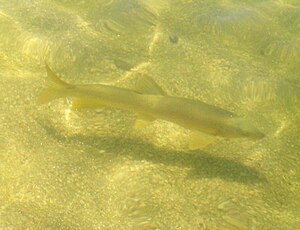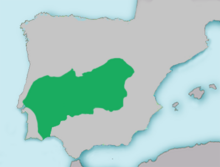Iberian barbel
| Iberian barbel | ||||||||||||
|---|---|---|---|---|---|---|---|---|---|---|---|---|

Iberian barbel ( Luciobarbus comizo ) |
||||||||||||
| Systematics | ||||||||||||
|
||||||||||||
| Scientific name | ||||||||||||
| Luciobarbus comizo | ||||||||||||
| ( Steindachner , 1864) |
The Iberian barbel ( Luciobarbus comizo ) is one of the large carp fish that are endemic to the Iberian Peninsula. In Portugal it is called Barbo-Focinheiro and in Spain Barbo Comizo or Comiza.
description
The Iberian barbel are streamlined and slender fish. In terms of appearance, they are very similar to the European barbel. The body is colored golden yellow. Their pectoral, ventral and anal fins have a slight orange to reddish approach. The two pairs of barbels are arranged around the mouth below. The longest ray of the dorsal fin is stiff and has a serrated rear edge. 49 to 51 scales are arranged on the sidelines. Males and females show a gender- typical dimorphism . During the spawning season, they develop a spawning rash typical of carp fish. The Iberian barbel is usually up to 50 centimeters long, but in exceptional cases much larger, up to 80 centimeters and more. Specimens weighing up to 18 kilograms were caught in the rivers Rio Tajo, Rio Guadiana and Rio Guadalquivir.
distribution and habitat
The Iberian barbel is common on the Iberian Peninsula in Spain and Portugal . It inhabits the slow-flowing lower reaches and reservoirs of large rivers such as the Rio Tajo , Rio Guadiana and Rio Guadalquivir . In the Guadalquivir river basin, however, it is almost extinct. There is still a sufficient population in the Rio Almonte and Rio Guadiana. Luciobarbus comizo prefers deep and stagnant water with lush underwater vegetation.
Way of life
The Iberian barbel feeds close to the ground on plants, small animals and smaller fish. While juvenile fish predominantly still eat invertebrates, adult specimens, with increasing size, specialize as predatory fish on small prey fish. The spawning season takes place in spring, from May to June.
use
In places where the Iberian barbel is still common, it is a popular sport fish for anglers because of its size and fighting power.
Hazard and protection
The Iberian barbel is considered to be endangered and is listed in the Bern Convention , Appendix III, as a species of fish worthy of protection. The population of L. comizo is believed to have decreased by 30% over the past decade since approximately 1990. This is due to uncontrolled water abstraction for agricultural irrigation, water pollution, dam construction, anthropogenic changes in their microhabitats and introduced foreign fish species, this has led to a continuous decline in the density of individuals and areas of distribution. However, the construction of dams also had the positive effect that the artificial creation of calm water zones increased the reproduction rate of the fish species.
The Iberian barbel is listed by the European Union in Appendix II of the Habitats Directive and is therefore considered a type of community interest, for whose preservation special protection areas must be designated by the member states.
Systematics
According to the IUCN classification , it belongs to the genus Luciobarbus . However, this is also relatively closely related to members of the genus Barbus and is therefore sometimes classified as a sub-genus of the genus Barbus . In the middle reaches of the Rio Tajo, natural hybridization with other Iberian barbel species such as Luciobarbus bocagei occurs very often . This hybridization makes phylogenetic studies performed using mitochondrial DNA difficult. The species has been found in the Rio Tajo for 800,000 to 1,000,000 years.
Web links
Notes and individual references
- ↑ a b c d e Iberian barbel on Fishbase.org (English)
- ↑ Translating the trunk barbel
- ↑ Peter S. Maitland: The Kosmos Fish Guide - The Fresh Water Fish of Europe in Color, Franckh'sche Verlagsbuchhandlung, Stuttgart, 1977, p. 156, ISBN 3-440-04468-8
- ↑ http://www.vertebradosibericos.org/peces/pdf/luccom.pdf ( Page no longer available , search in web archives ) Info: The link was automatically marked as defective. Please check the link according to the instructions and then remove this notice.
- ^ Fishing World Records
- ↑ http://www.ucm.es/info/zoo/Vertebrados/ictiologia/Extremadura/ResultadosExtremadura2008.pdf
- ↑ AJ Crivelli: Luciobarbus comizo on IUCN 2010, IUCN Red List of Threatened Species, 2006, Version 2010.4. www.iucnredlist.org
- ↑ http://www.earthsendangered.com/profile.asp?gr=F&sp=11037
- ↑ https://apiv3.iucnredlist.org/api/v3/taxonredirect/2575
- ↑ https://apiv3.iucnredlist.org/api/v3/taxonredirect/2575
- ↑ Ana Almodóvar, Graciela Nicola and Elvira Benigno: Natural hybridization of Barbus bocagei x Barbus comizo (Cyprinidae) in Tagus River Basin, Central Spain, 2008, Cybium Vol. 32 (2): 99-102 on http: //www.ucm .es / info / zoo / Vertebrados / elvira / Almodovaretal2008.pdf
- ↑ http://www.vertebradosibericos.org/peces/pdf/luccom.pdf ( Page no longer available , search in web archives ) Info: The link was automatically marked as defective. Please check the link according to the instructions and then remove this notice.
